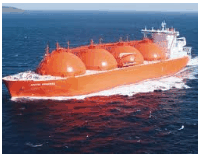
Cross-posted from The Conversation
The Browse Basin off the north west coast of Australia is rich in liquified natural gas (LNG), but questions remain over how best to exploit it. Oil and gas companies and the Australian Federal Government have approved new floating LNG technology (FLNG) which would remove the need for processing onshore on the coast of Western Australia. However, the WA government is less convinced of the benefits. So what are the stakes?
Maturing industry
The resource rich state of WA has enjoyed the benefits of mining and offshore oil and gas development for decades. However, the newest addition to the offshore energy portfolio, FLNG, has met some resistance. FLNG disrupts the established economics of gas development by eliminating the onshore element and the associated construction works, whilst improving the economics of smaller remote fields that might never be developed in the conventional onshore manner.
As FLNG technology has matured and costs pressures in Australia have risen, the see-saw for Browse has pitched from an onshore option to FLNG.
Australia is an expensive place to do business. The emergence of new players into the gas supply market (the US, Canada and Africa) increases the need for Australia to improve competitiveness in the energy sector to retain market share.
Competitiveness is achieved through innovation. Operating in a globally competitive environment demands the need for companies to be innovators of new technology, rather than just users of conventional methods.
There are numerous examples of industries suffering from late adoption of disruptive technology. Music distribution, newspaper and book publishing industries have had to rapidly revisit their business models to keep pace with new technologies. In each case, being first mover is essential – as evidenced by the dominance of iTunes and Amazon in their newly-established marketplaces.
Innovations in engineering and technology must be embraced if Australia is to remain a player in the energy supply market. WA has the opportunity to become a hub for innovation and FLNG expertise – that will not only will service a domestic FLNG industry but develop expertise that can be exported worldwide. WA has the chance to develop an export market in the expertise to operate FLNG facilities – such as engineering, logistics and operations – alongside the export market of the actual oil and gas.
FLNG in the Browse Basin
The decision about onshore or offshore processing of Browse gas has been made – it was made months ago. AU$2 billion and 4.5 million work hours were spent on a technical and commercial assessment of the onshore processing solution. Joint Venture Partners decided against the traditional approach of onshore processing. FLNG developer Royal Dutch Shell’s chief executive Peter Voser last week told the press, “An onshore project in WA was just not possible. It is not a question of whether it is a floating or an onshore project, it is whether it is floating or no project.”
The oil and gas companies and Federal Government are on board. So why isn’t WA?
One of the current sticking points is the WA State Government’s refusal to renegotiate the leases to allow the part of the Browse field gas that lies in WA (rather than Commonwealth) waters to be processed offshore.
The majority of the enormous reserves of Browse gas (estimated at 15.5 trillion cubic feet, tcf) lies in Commonwealth waters and as such is covered by federal Petroleum Resource Rent Tax if developed. A small portion of the gas belongs to the state of WA and would therefore provide direct tax revenue to the State Government.
There is disparity in the estimates of the amount of gas that lies in State rather than Commonwealth waters. The WA premier Colin Barnett says up to 15% while Royal Dutch Shell’s chief executive Peter Voser says the number is more like 5%.
The exact number is somewhat irrelevant. A characteristic of an FLNG solution is that a field the size of Browse can be developed in stages. Depending on the reservoir shape, Woodside and the JV partners could put one or two ‘Prelude-sized’ FLNG facilities in the Browse Basin to extract the gas in Commonwealth waters, leaving the remaining gas – whether it is 5% or 15% of the total – that lies within the WA state boundary in the sea floor.
Woodside Petroleum chief executive Peter Coleman has commented publicly that state approvals for the Browse floating LNG project “are important [but] they’re not critical to our decision one way or the other”. He added that “it’s not desirable” to go ahead with the project without State approval, “because there will be interactions with the State, whether it be around supply bases or other activities”.
As premier, Colin Barnett has the prosperity of the State and its population as his priority. His initial push for an onshore processing option for Browse gas, to secure the resulting construction jobs and indigenous investment, is commendable.
However, the maturation of FLNG technology has taken the onshore processing option away. Attempting to block an FLNG-based Browse development is now most likely to push the oil and gas majors elsewhere worldwide, rather than bringing them back to a Browse onshore option. The inevitable global growth of FLNG means WA would be wiser to embrace this new technology, capitalise on our first mover advantage and invest in education and training so that the State can provide the type of jobs that this opportunity presents.
Huge potential exists for WA to become a knowledge hub to provide the engineering, operational and maintenance services for the FLNG industry – not only to support the Australian FLNG industry but to be exported worldwide.
Article by Susan Gourvenec, Professor, Offshore Geomechanics at University of Western Australia

